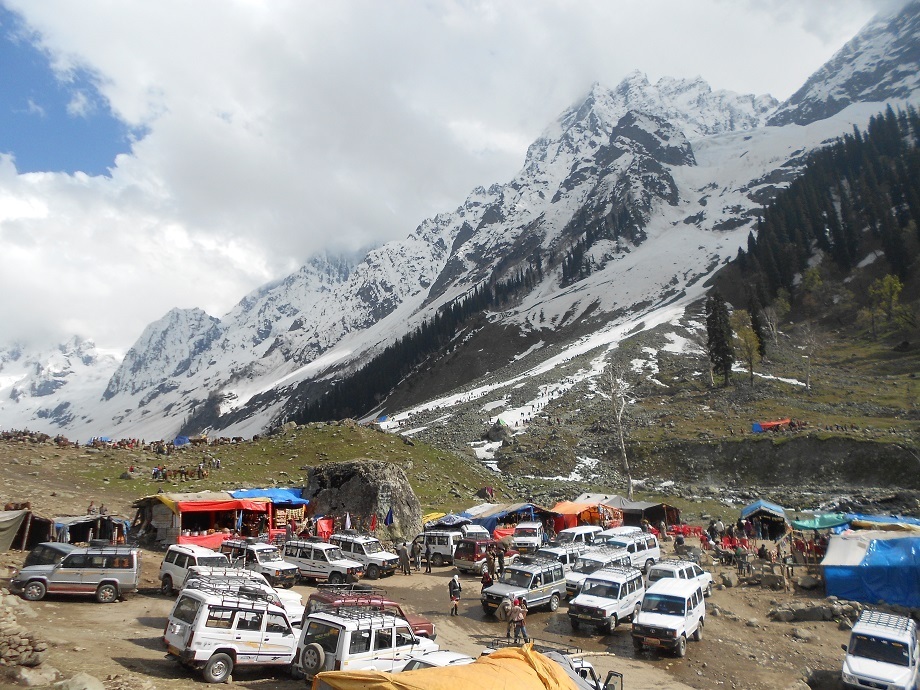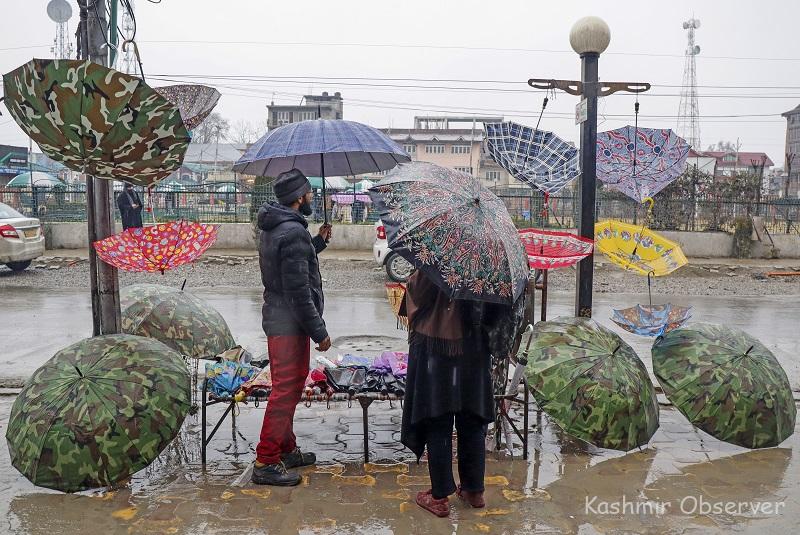
The rapid conversion is also one of the causes of the Kashmir floods. The paddy fields along the Jhelum acted as a temporary reservoir during the flooding which prevented the sudden overflow of floodwater.
Dominated by the Himalayan and Karakoram ranges, Kashmir is home to perennial rivers, pristine lakes, clear streams, grand meadows and many unexplored places. With the increasing population, the encroachment on the natural resources has increased creating many environmental problems in the valley.
Melting of glaciers: Kolahoi, the largest glacier in Kashmir and the originating point of two significant tributaries of the river Jhelum – Lidder, and Sindh is melting rapidly. A new research paper has revealed that the largest glacier of Kashmir has further reduced in the area over three years. The research compares the recent findings to that of a 2017 study.
“Kolahoi Glacier has rapidly receded due to climatic changes prevalent over the Kashmir region. The glacier has lost 23% area since 1962 and has fragmented into smaller parts,” the paper published in the International Journal of Environmental Research and Public Health of April 19, 2020, revealed.
Irfan Rashid one of the authors of the research told Kashmir Observer that besides climate warming they have also observed that aerosol concentrations especially black carbon is among the highest reported from the Himalayan glaciated landscapes.
Black Carbon is organic carbon that is wind-driven and deposited on the glacier surface. It is mostly from fossil fuel (automobiles, factories, brick kilns, etc) and firewood burning (charcoal making in autumn, firewood for burning, hammam’s in winters).
While the research only took Kolahoi glacier as a point of the study, there are other glaciers in Kashmir like Thajiwas group of glaciers, Nehnar, Hoksar which are in a much worse condition, stressed Rashid.
“The Kashmir valley glaciers are showing accelerated retreat as compared to the rest of the Hindukush Himalaya,” said Ulfat Majeed coauthor of the research. Small-sized glaciers, clean glaciers (glaciers without debris), and the glaciers associated with proglacial lakes are showing greater retreat rates in the valley added Majeed.
Conversion of agricultural land into horticulture land: Many farmers in Kashmir have converted their agriculture land into orchards as they earn better in horticulture.
According to research, irrigation-intensive agriculture in the Lidder watershed area has shrunk by 39%, whereas the orchards have expanded by 177% from 1980 to 2017.
“The conversion of irrigation-intensive agriculture lands (rice paddy) to less water-intensive orchards is attributed to economic considerations and depleting streamflow,” the paper mentions.
Though economically beneficial, the production of horticultural crops creates many environmental problems. In paddy fields, the static water helps to recharge the groundwater. With fewer paddy fields, Kashmir may face scarcity of groundwater in the coming time.
The rapid conversion is also one of the causes of the Kashmir floods. The paddy fields along the Jhelum acted as a temporary reservoir during the flooding which prevented the sudden overflow of floodwater.
Timber Smuggling: The recent pandemic lockdown may have helped the air to get cleaner but not the looting of the green gold of Kashmir. According to reports hundreds of trees are chopped off and systematically transported by smugglers with the help of horses and trucks from Shopian, Kulgam, Bandipora, Baramulla, Anantnag, Ganderbal, Budgam and Kupwara areas of Kashmir.
According to the Kashmir Chamber of Commerce and Industry (KCCI) spokesperson, “The plunder is doing irreparable damage to forests and the lucrative profits seem to have drawn unscrupulous elements from all sections.”
Since the implementation of Indian Forest Act in the valley, smuggling of timber has become a bailable offense which has left the Forest Department’s hand-tied. With the Jammu & Kashmir Reorganization Act 2019 coming into effect, the Jammu & Kashmir Forest (Conservation) Act, 1997 was scrapped due to which the Public Safety Act which allows officials to book timber smugglers is no more applicable in the valley, giving a free hand to illegal logging and smuggling.
“Between August and October 2019 the Forest Department has reportedly filed 59 cases of alleged timber smuggling,” mentions the KCCI spokesperson.
The KCCI requested the Lt Governor of J&K G C Murmu to take stringent actions against officials of the concerned Departments for not taking proper action to save the green gold of the valley. “The government should not shy away from even dismissing senior officials from service for criminal misconduct and gross negligence,” said the spokesperson.
Endangered Hangul: While the pictures of 10 Hangul in Shikargah Tral might seem to make people appreciate their beauty but the population of this critically endangered species is decreasing at an alarming rate in the valley.
Also known as the Kashmir stag, it is the only Asiatic survivor of the European red deer. According to the International Union for Conservation of Nature’s (IUCN) Red Data Book, Hangul is being declared as critically endangered in Jammu & Kashmir along with Markhor (wild goat) and Tibetan antelope.
According to a research paper by Riyaz A Bhat, Kashmir’s shikar map prepared by Maharaja Hari Singh showed that Hangul was distributed in a radius of 40 km spreading from Karen in Kishenganga to Dorus in Lolab valley, Erin catchments in Bandipora to Chamba district of Himachal Pradesh.
With continuous encroachment of land, this wildlife species loss their habitat and are confined to Dachigam National Park and adjoining protected areas in the Greater Dachigam landscape, mentions the paper.
The latest population monitoring survey of Hangul conducted by the Wildlife Department in 2019, revealed that the number of Hangul in Dachigam and nearby areas is 237. According to earlier population estimates the number of Hangul was 197, 186, and 182 in 2004, 2015, and 2017 respectively. The report also mentioned a sharp decline in the fawn-female and male-female ratio of Hangul.
Encroachment of water bodies: Dumping of waste in water bodies has degraded the quality of water bodies in the valley. Wular lake, a Wetland of International Importance (Ramsar site) is one such water body which is dying a slow death due to constant dumping of Municipal Solid Waste. According to official reports, 27 sq m of the lake has silted up and turned into a landmass.
In 2017 thousands of fishes were found floating on the surface of the Jhelum river due to oxygen depletion and high pH levels in the water. The Jhelum river originates in south Kashmir and passes through Srinagar before entering South Asia. Heaps of plastic, household waste, and sewage water is a common sight on the river.
Many water bodies in Kashmir are facing the same fate as Wular and Jhelum. “Water from industries and laboratories is dumped into the water bodies directly,” says Suhail Bashir, an environmentalist who is researching on the encroachment of water bodies in Kashmir.
The Mughal Gardens were made keeping the environment in mind, says Bashir. “Trees were planted to maintain the flow of water and preserve soil from erosion.”
According to a study by Urfan Ali, the machines used for the removal of nutrient-rich sediments and aquatic plants from the Dal Lake, Wular lake, Anchar Lake and Manasbal Lake resulted in the loss of biodiversity. Due to the use of mechanical de-weeder, many species of zooplankton have been lost in the mentioned water bodies, suggests the study.
“The Dal Lake, Wular Lake, Anchar Lake, and Manasbal lake water is alkaline, moderately hard, and nutrient-rich in NO3-N and P-PO4.”
Follow this link to join our WhatsApp group: Join Now
Be Part of Quality Journalism |
Quality journalism takes a lot of time, money and hard work to produce and despite all the hardships we still do it. Our reporters and editors are working overtime in Kashmir and beyond to cover what you care about, break big stories, and expose injustices that can change lives. Today more people are reading Kashmir Observer than ever, but only a handful are paying while advertising revenues are falling fast. |
| ACT NOW |
| MONTHLY | Rs 100 | |
| YEARLY | Rs 1000 | |
| LIFETIME | Rs 10000 | |










